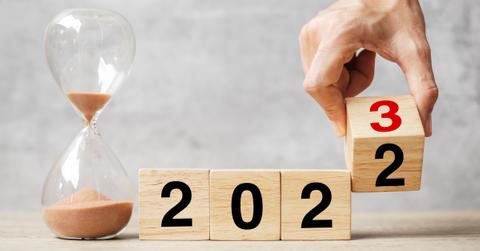Don’t Forget to Add These 5 Things to Your End-of-Year Financial Checklist
Your end-of-year financial checklist should include assessing your budget and reviewing your credit score. Here are a few other suggestions.
Dec. 28 2022, Updated 2:09 p.m. ET

The end of the year is the perfect time to reflect on the past 12 months and create a lengthy New Year’s resolution list. It's also a time to assess your finances. How much did you spend on those afternoon runs to Starbucks in 2022? Did you meet your emergency savings goal? Clearly, there's a lot to consider which is why you’ll need an end-of-year financial checklist to keep you organized.
Not sure what to include on your end-of-year financial checklist? We’re starting you off with five suggestions.
What is a financial checklist?

A financial checklist is a list of tasks meant to help assess your financial well-being and keep you on top of your finances. From spending habits to budgets to credit scores, your financial checklist should include an array of tasks that aim to keep you on track and determine areas of improvement.
Financial checklists can be created at any time of the year, though it’s a good idea to create one towards the end of the year so that you can enter the next year with a new (and better) plan. Whether you’re looking to save more money, improve your credit score, or find out if you developed bad spending habits, a financial checklist is one tool that can help.
What should I include on my end-of-year financial checklist?
Your end-of-year financial checklist should be tailored to your particular goals. You might also include the following items on it.
1. Review your credit score and report.

A good credit score, which Equifax says is between 670 and 739, can open the doors to many opportunities including lines of credit, mortgage approvals, and more. Review your credit score to see where it stands and if it needs some work. Additionally, you should scan through your credit report to ensure any new inquiries made in the past year belong to you or if any items on it can be disputed.
2. Assess your credit cards and interest rates.

If you’re carrying credit card debt with you into the new year, find out which of your credit cards have the higher interest rates. You’ll want to pay these down first. Also, if your credit score improved over the past year, consider contacting your creditors and requesting lower interest rates.
3. Update your beneficiary information.

If you experienced any major life events this year such as divorce or a death in the family (condolences to you), you’ll want to revisit your beneficiary information on things like life insurance or retirement accounts. Even if you didn’t experience any of the unfortunate events listed above, it’s still important to review your beneficiary information regularly to ensure everything is still accurate.
4. Review your budget.

If you set a budget for 2022, did you stick to it? Could you have spent a little smarter? It's a good idea to comb through your accounts at the end of the year to see how much you actually spent on take-out or non-essential items. Knowing what you could have saved may help you plan better for the next year, and possibly save more.
5. Reassess your tax withholdings.

The year may be coming to an end but it marks the beginning of tax season. If you are recently divorced, married, or had a child in 2022, you’re going to want to revisit your Form W-4 so you can update it accordingly. Based on the changes you make, you could have less money taken out of your paychecks.
Here are a few other things you’ll want to include on your end-of-year financial checklist:
- Evaluate your investments and decide whether changes need to be made. Does your portfolio need more diversifying?
- Look into whether you need to update your insurance coverage or change plans.
- Start preparing for the tax season.
- Review your savings and decide if you need to create a new budget to meet your savings goals.
Although you are creating an end-of-year financial checklist, many of the suggestions we provided can also be included on a mid-year financial checklist as well.
